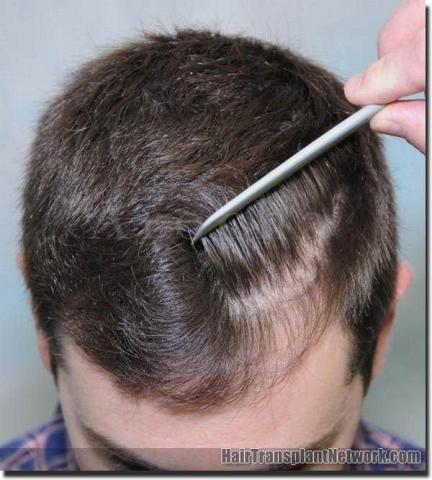Hair transplantation is really about relocating (transplanting) the bald resistant hair follicles from the back of the head to the balding areas on the top of the head.
This process works for a lifetime because the hair follicles taken from the back of the head are genetically resistant to baldness, regardless of where they are relocated to.
Hair transplantation, when done right, can be so natural that even your hair stylist will not know that you've had it done.
But the skill and techniques of hair transplant surgeons does vary widely, as do their results. It's important to choose the right procedure and clinic to assure that you will get completely natural results.
The state of art hair transplantation procedure that we recommend is called "Follicular Unit Hair Transplantation".
To learn more about the leading hair transplantation physicians who perfrom this procedure, visit our recommended physicians page.
A typical session of between 1,500 to 3,000 grafts normally involves a full day of surgery on an out patient basis. Most patients will arrive in the morning and will have their procedure completed by late afternoon.
View a step by step overview of a typical hair transplant procedure.
Patients are given local anesthesia in the donor and recipient areas. Most patients find that once the anesthesia is given that they feel no pain or discomfort during the surgery. Following surgery patients will typically feel some amount of soreness and numbness, with some mild discomfort. Most patients are pleasantly surprised by how minimal the discomfort from the surgical procedure is.
Today hair restoration clinics typically provide free no obligation consultations, with surgical sessions priced either per graft or by the session. Prices typically average around $5 to $6 per graft.
It is normal for the price per graft to drop as the size of the surgical session increases. Many clinics will offer a reduced rate per graft once a certain surgical session size (i.e. 1,000 or 2,000 grafts) is exceeded.
To compare the long term costs of hair transplantation to other hair loss treatments, visit our hair transplant cost section.
The amount of grafts you will need ultimately depends on your degree of hair loss, now and in the future, and on how full you desire your hair to be.
For help estimating the amount of grafts/hairs you may need, click here.
To use our interactive graft calculator, click here
With today’s very refined micro hair transplantation procedure the incisions are very small and less invasive than past procedures. This results in more rapid healing. Most patients feel fine within a day or two following surgery, although some numbness and mild soreness can be expected for several days following surgery.
Immediately following surgery a patient’s recipient area is typically pink with scabs forming around the micro incisions. These hundreds of tiny incisions will heal rapidly within a week to ten days.
During the first few days after the surgery a person’s hair transplants will be noticeable if there is no previous hair to mask these temporary scabs. However, most patients feel comfortable being in public without wearing a hat within 5 to 7 days following surgery.
Once the transplanted hair grows out the results should look entirely natural, even under close examination.
Normally it takes between three to five months following surgery before the transplanted hair follicles begin to grow new hair. The transplanted hair grows in very thin initially and gradually grows thicker and fuller over time. After one year a patient’s transplanted hair will be fully mature and will continue to grow for a life time.
Since the hair follicles that are transplanted to the balding areas are genetically resistant to going bald, they will continue to grow for a life time – just as if they had been left in the bald resistant donor area.
To understand why some hair follicles are genetically resistant to going bald, while other are not, click here.
The most important decision in restoring your hair is the physician you choose. The skill, talent, and experience of hair restoration physicians vary widely, as do the end results. Who you choose will determine how natural and full your new hair will be for the rest of your life.

















